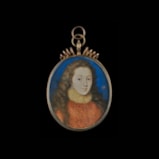PETER OLIVER
(c.1594-1647)Venetia, Lady Digby (née Stanley) (1600-33), wearing an embroidered orange and gold dress, with ‘saffron’ lace ruff and earrings, her long wavy hair falling to her shoulders
Circa 1615-1620
Watercolour on parchment
Signed with initials PO
55 mm (2 ¹/₈ inches) high
SOLD
Before she would see Digby again, Venetia had become wrapped up in salacious rumours relating to her and other members of the Stuart court. It seems that her beauty had led people to believe that she had multiple lovers, including Sir Edmund Wyld and the Brothers Richard and Edmund Sackville (who would later become the 3rd and 4th Earls of Dorset respectively). These rumours went so far that a later commentator, John Aubrey (1626-97) reported that a sign reading ‘PRAY COME NOT NEER,/ FOR DAME VENETIA STANLEY LODGETH HERE’ [2] was placed above her bedroom door.
In 1624, Digby returned from Europe, and he and Venetia married in secret, so as to avoid the disapproval of their parents. It is thought that their marriage was devoted, though Venetia had struggled throughout six childbirths, which Digby himself had described as being ‘exceeding painful and dangerous’ [3]. This devotion was marked following Venetia’s sudden death at the age of 33, the day of which Digby commissioned Van Dyck to paint a portrait of his wife on her deathbed, which can now be found in the Dulwich Picture Gallery [4].
As the son of Isaac Oliver, Peter Oliver had been taught how to limne by a great master of the art, and this is certainly clear in the present example. His style was extremely close to that of his father’s and often the differences between the works of the two are difficult to decipher. Aside from his connections to his father, he enjoyed a successful career under the patronage of Charles I, Prince of Wales. It was under Charles that he had gained the responsibility for painting copies of Italian Paintings entering the Royal Collection which were highly valued. [5] Peter inherited his father’s drawings, miniatures and materials, as well as his position at court serving Charles as both Prince of Wales and eventually, King of England.
[1] Burghley House Collections, MIN0019.
[2] A.Clark (ed.), ‘Brief Lives’, Chiefly of Contemporaries, set down by John Aubrey, between the years 1669 & 1696 (2 Vols., Oxford, 1898), pp. 229-30.
[3] A.Clark (ed.), ‘Brief Lives’, Chiefly of Contemporaries, set down by John Aubrey, between the years 1669 & 1696 (2 Vols., Oxford, 1898), pp. 229-30.
[4] Dulwich Picture Gallery, DPG194.
[5] Peter completed his father Isaac’s great unfinished work of The Entombment for Charles.
M. Papier Collection.

shipping notice
Worldwide shipping is included in all prices.
The Limner Company does not accept any responsibility for import duty, this is to be paid by the buyer.
Some stock items contain materials from endangered species which are governed by CITES regulations and will require a permit to export outside of Great Britain. If a certificate of export is required then this will be the responsibility of and paid for by the buyer .
you may also like













